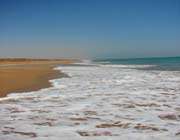Gulf of Oman Coasts (Part 3)

At times, the Gulf of Oman and the Persian Gulf were considered as the Persian Gulf and the southeastern shores of Iran used to be called the Sea of Mokran and the Sea of Kerman. The Sea of Kerman was bounded by the Sea of Mokran on the east and putting behind Kish Island it included parts of the Persian Gulf. The Sea of Mokran stretched to the Sind River on the east and to the Sea of Kerman on the west. Apparently the southern extremes of these two seas used to be called the Gulf of Oman. Kerman Wharf on the Sea of Kerman was called Hormuz and Mokran Wharf on the Sea of Mokran was called Tiz. According to Afzal al-Din Kermani, Tiz Port and Mokran Wharf were called transcontinental port in a period marked before the invasion of the Mongols. It had trade relations with Egypt, Ethiopia, Zanzibar in Africa and with India, Sind in Central Asia and with Arab nations including Oman and also with the Island of Bahrain in the Middle East. During that period, Mokran exported goods such as sugar and sugar lump, musk, ambergris, velvet fabrics and other commodities to Tiz.
The Gulf of Oman is very important economically and geopolitically, since it is part of the sea route between the Persian Gulf and its oil-rich regions to Indian Ocean, Far East, Mediterranean Sea and Europe. According to the Oil Regulations passed in August 1957, the Iranian Plateau on the Gulf of Oman fell subject to the oil regulations like the Persian Gulf. Iranian Fisheries Co., too, has installations on the northern shores of the Gulf of Oman.
Archeological studies have unearthed prehistory relics on southern shores of Chabahar, Jask and Minab, located 200 meters below sea level, on northwest Konarak peninsula and on the shores of a river in the south of the village of Sadaij (almost 100 km northeast Jask) and 10 km off southeast Kuhestak (a village 48 km off southern Minab). The unearthed relics in Sadaij belong to some 6500 to 7500 BC and those found in Konarak belong to Middle Paleolithic or Middle Stone Age.
Translated by: Sadroddin Musawi
Other links:
Laft Village
Gulf of Oman Coasts (Part 1)
Gulf of Oman Coasts (Part 2)